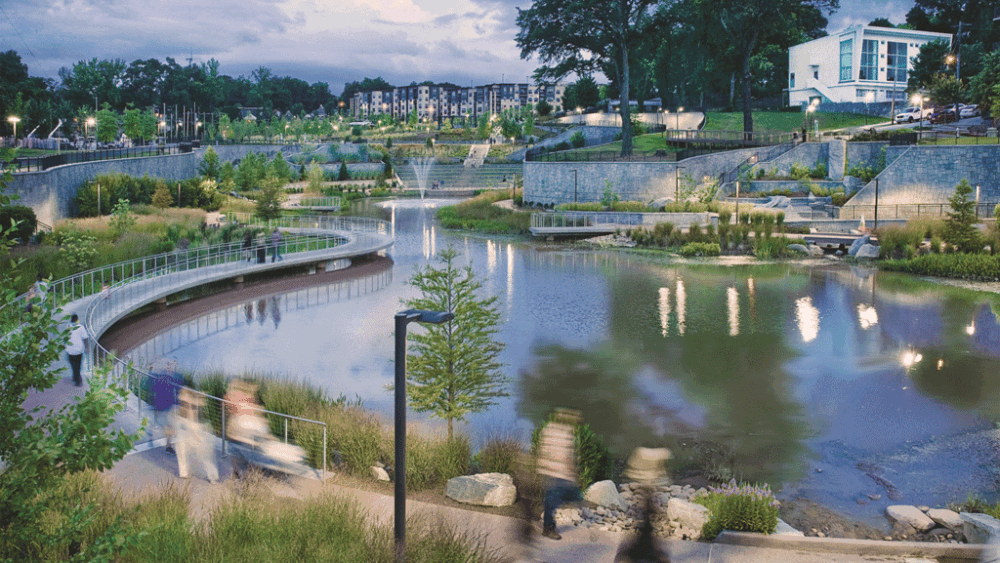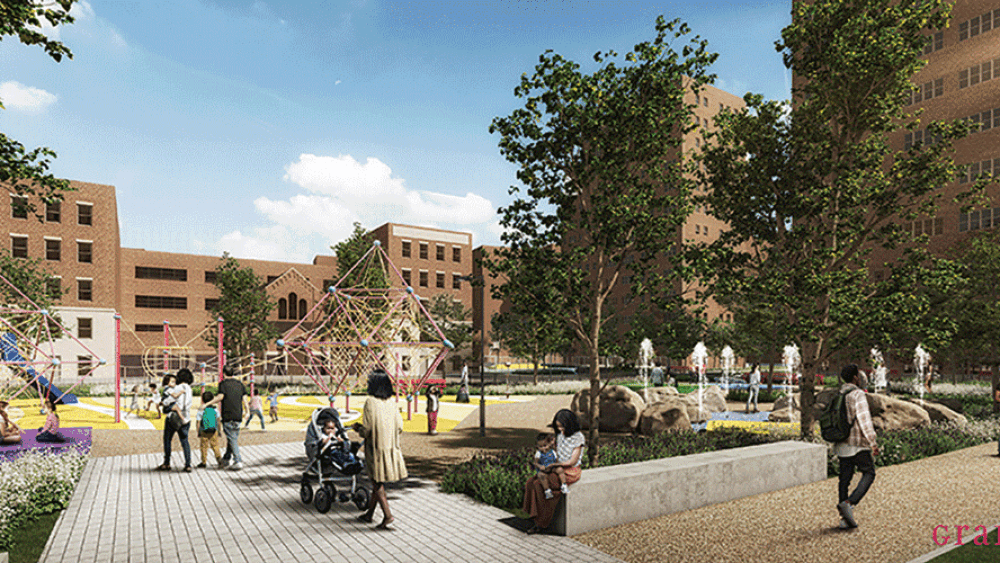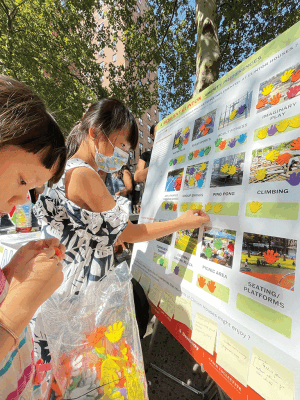On the evening of September 1, 2021, the remnants of Hurricane Ida reached New York City, unleashing torrential rains that overwhelmed the city’s sewers and sent water surging into roadways, basements, and subways. The storm set an hourly rainfall record of 3.15 inches (8 cm) for Manhattan, breaking one set by Tropical Storm Henri less than two weeks earlier.
Ida’s sudden, widespread flooding caused hundreds of millions of dollars of damage, particularly to residential properties, and took the lives of 13 people in the city.
Extreme rainfall events, sometimes called “cloudbursts,” are growing more severe and more frequent due to climate change. The National Climate Assessment calculated a 71 percent increase in the annual amount of precipitation from heavy rain events 1958–2012 in the northeastern U.S. The New York City Panel on Climate Change anticipates that, by the end of the century, the city could experience as much as 25 percent more annual rainfall than it does today, and 1.5 times as many days with more than one inch of rain.
Cloudbursts occur quickly and can flood low-lying areas that have poor drainage. They can be devastating for affected residents, particularly ones who are in a low-income bracket, have limited mobility, speak languages other than English, are undocumented, and/or are experiencing homelessness.
Impacts include the risk of drowning, submerged power lines, exposure to contaminated water, transportation disruptions, and financial burdens. New York City is actively working to make its neighborhoods more resilient to such extreme rain events by upgrading and better maintaining sewers, installing green infrastructure, and enhancing natural drainage corridors, among other changes.
As part of this effort, the New York City Housing Authority (NYCHA) and Department of Environmental Protection (DEP) are partnering to implement stormwater management solutions on NYCHA properties that reduce flooding from cloudbursts and improve residents’ lives.
A partnership emerges
NYCHA, the largest public housing authority in the nation, has 2,411 buildings across 335 developments that are home to more tan 360,000 people. NYCHA’s properties are large, campus-style developments with many buildings, green spaces, pathways, and parking lots. NYCHA maintains an extensive network of sewer lines on its properties, which connect to the city’s system.
DEP and NYCHA have been collaborating on stormwater management since 2011 with the goals of decreasing the amount of stormwater that goes into each of their systems and reducing combined sewer overflows. Meanwhile, DEP published a Cloudburst Resiliency and Planning Study in 2017 through a partnership with the city of Copenhagen. The study explores ways to address intense rainfall through the integration of traditional underground drainage infrastructure with above-ground solutions that create amenities for the community. It focused on a pilot area in Southeast Queens, the home of NYCHA’s South Jamaica Houses.
New York City’s cloudburst program grew out of the longstanding DEP-NYCHA partnership, the 2017 study, and the recognition that site-specific interventions combining gray infrastructure, such as sewer pipes and underground storage tanks, and green infrastructure, including trees and rain gardens, can play a key role in managing large volumes of rain in vulnerable locations while providing attractive outdoor public spaces.
“The cloudburst program was different from the green and gray infrastructure improvements that were happening citywide,” says Siobhan Watson, who managed the program and is now a sustainability lead at NYCHA. “It was our opportunity to really make a difference in key at-risk locations, both in terms of handling very large volumes of rain and mitigating the flooding they were experiencing, and in making outdated green spaces work better for the community.”
The first pilot at the South Jamaica Houses
The South Jamaica Houses encompass eight city blocks and 23 acres (9.3 ha) in the South Jamaica portion of Queens, where the existing stormwater drainage system has limited capacity, and local flooding from rainstorms is becoming an increasing problem. Twenty-seven apartment buildings are arranged along tree-lined streets, pedestrian walkways, and a four-block greenway. The community of 2,600 residents has an active community garden program and a strong interest in its public spaces.
An engineering study identified a two-block stretch of the greenway that has the lowest elevations and is best suited to capture stormwater. The team of engineers, urban designers, and landscape architects developed alternatives for those blocks by using varying combinations of above-ground green infrastructure features and underground retention tanks.
The team brought these alternatives to the residents through a series of public meetings and workshops. Residents indicated support for the concept of “sunken” landscape spaces for temporary stormwater retention, particularly when those spaces offer seating and other accommodations for people of all ages and physical abilities during normal times. Accordingly, the final project design centers on a basketball court that is recessed into the ground to hold stormwater during heavy rains and drain into below-grade retention tanks and the stormwater system within 48 hours.
The court will include seating around the outer edges, reduced fencing, and improved painting, lighting, and backstops. The greenway will have two bioretention assets flanked by stone seating and a new paved pathway. The project is now proceeding to construction.
“The pilot at the South Jamaica Houses goes far beyond traditional green infrastructure treatments,” says Watson. “Its ability to store and slowly release large volumes of stormwater and its
community-centered design show that a single project can have a significant impact on both flooding and residents’ quality of life.”
Leveraging national best practices
Building on the South Jamaica pilot, which was led by DEP, NYCHA was eager to identify a set of additional developments to prioritize for cloudburst infrastructure. The Housing Authority focused on properties that were both vulnerable to the impacts of heavy rain and had high need for investment in their open spaces. They included inland sites, such as Woodside Houses in Queens and Butler Houses in the Bronx, as well as sites with combined coastal and rainwater flooding vulnerability, such as Sheepshead Bay Houses and Breukelen Houses in Brooklyn.
NYCHA knew that any investments it made in these pilots needed to serve two purposes: to mitigate the impacts of extreme rain and to transform the public realm for NYCHA residents. To do so, the organization wanted to bring in the best ideas that it found around the country.
NYCHA asked ULI New York and ULI’s Urban Resilience program to convene a technical assistance workshop to focus on innovative cloudburst infrastructure that can protect against extreme rainfall events while providing opportunities for passive and active recreation during everyday conditions.
“Working alongside ULI’s team of leading design professionals and experts in landscape, infrastructure, and public space was an amazing opportunity for NYCHA to learn from best practices in the industry and to think laterally about the co-benefits of cloudburst implementation at NYCHA campuses,” says NYCHA Senior Director of Architecture and Engineering Services Dylan Baker-Rice. “The participatory process and feedback from ULI were critical in establishing criteria for locating the most vulnerable areas and maximizing the impact of cloudburst infrastructure.”
Based on a recommendation from the technical assistance panel to maximize cross-pollination and consistency, NYCHA selected one team to work on the set of inland sites and one to work on coastal zones. Design for these projects is expected to begin shortly.
“Through this cloudburst program, New York City, NYCHA, and DEP are once again leading in developing strategies that link climate resilience with urban livability, especially for the communities most impacted by climate risk,” says August Williams-Eynon, a manager with ULI’s Randall Lewis Center for Sustainability in Real Estate, who collaborated with NYCHA. “The ULI Urban Resilience team has been thrilled to work with our local partners ULI New York and NYCHA to provide technical assistance as this initiative takes shape.”
Lessons learned and the path forward
Although it is still in its early stages, New York City’s cloudburst program has already influenced NYCHA’s and other city partners’ thinking about the role of public green space in climate resilience. “We now know that we have to consider climate goals as we improve open space,” Watson says. “When we have funding for open space, we’re going to be asking how we can accomplish multiple goals.”
The program has also elevated the opportunity presented by NYCHA’s portfolio to improve resilience and quality of life for thousands of residents in outdated developments. Upgrading amenities can transform residents’ everyday experiences while reducing the disruptions caused by rain events. NYCHA’s green spaces are a significant component of the city’s network, and opportunities abound to expand the program and make an even greater impact.
NYCHA is working to tap into federal funding to grow the cloudburst program and has learned the importance of raising local allocations to serve as matching dollars. For example, an allocation by the mayor’s office was critical to securing a FEMA grant.
Along with the green and gray infrastructure work that DEP is doing at the neighborhood level, as well as new rules for managing stormwater and the building renovations NYCHA is undertaking, the cloudburst program is part of a robust suite of initiatives that are making a meaningful difference in New York City’s resilience.
“We’ve learned some hard lessons in recent years. Hurricane Sandy showed us the threat of coastal storms. Now, because of Ida, we know what heavy rains can do,” Watson says. “Through the cloudburst program and other efforts, we’re acting on what we’ve learned, so that next time, we’re more prepared.”
ULI’s technical assistance to NYCHA was made possible through the support of the JPMorgan Chase Foundation, in partnership with ULI and the Resilient Land Use Cohort program, which seeks to inspire actionable climate adaptation and resilience efforts and share best practices across the U.S.








